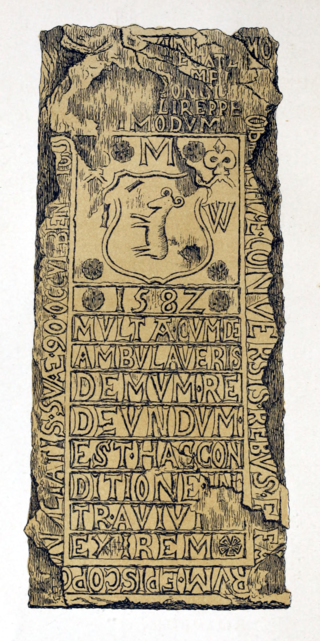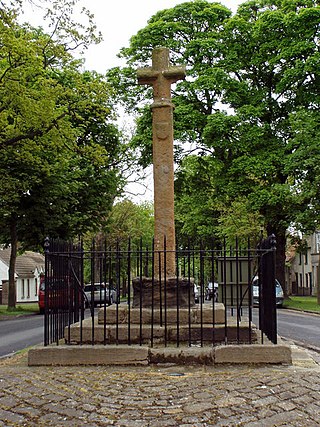Related Research Articles

John Knox was a Scottish minister, Reformed theologian, and writer who was a leader of the country's Reformation. He was the founder of the Presbyterian Church of Scotland.
John Willock was a Scottish reformer. He appears to have been a friar of the Franciscan House at Ayr. Having joined the party of reform before 1541, he fled for his life to England. There he became noted as a zealous and taking preacher. This led to his arrest for heresy under an Act of Henry VIII., "for abolishing diversity of opinion" in matters of religion. He was found guilty of preaching against purgatory, holy water, priestly confession, and prayer to the saints, and of holding that priests might lawfully be married, he was for some time confined in the Fleet prison. After the accession of Edward VI he was chaplain to Henry, Duke of Suffolk, who had married King Henry's niece, and is best known as the father of Lady Jane Grey. He preached for a time in London, in St Katherine's Church, when both he and John Knox, his fast friend, were granted general license to preach anywhere in England. Henry, Earl of Huntingdon, presented him to the rectory of Loughborough in Leicestershire, a living which he continued to hold during King Edward's reign, and again during that of Queen Elizabeth for the rest of his life. Thus in his later years he was in the unique position of being at the same time a parish minister in both England and Scotland. When Mary Tudor came to the English throne in 1553, Willock fled to Embden, in the Protestant Duchy of Friesland. There he practised as a physician with much success, and rose to some eminence. In 1555, and again in 1556, the Duchess Anne of Friesland sent him to Scotland as her Commissioner on matters of trade. In 1558 he returned home, and preached for some time in Dundee, with much acceptance among the friends of reform. In 1559, when John Knox had to leave Edinburgh in peril of his life, Willook took his place as the evangelist of the Reformation. It was then that he conducted in St Giles what is believed to have been the earliest public celebration of the Holy Communion in Scotland after the reformed ritual. In 1560, when Queen Mary of Guise lay dying, the Earls of Argyll and Moray, and other Lords of the Congregation advised her to "send for a godly, learned man of whom she might receive instruction"; and Willock was chosen to minister to her, which he faithfully did. That same year he was made Superintendent of Glasgow and the West. He was also one of the six Johns entrusted with the drawing up of the First Book of Discipline, the others being John Knox, John Winram, John Spottiswood, John Douglas, and John Row. Sometime in that year he went to England, and brought home his wife, Katherine Picknavell, an English lady. He was chosen Moderator of the General Assembly in 1563, 1564, 1565, and 1568. In 1565 Queen Mary endeavoured to put a stop to his activity by having him imprisoned in Dumbarton Castle; but the Reformers were now too strong for her, and she had to depart from her purpose.
Mary Livingston was a Scottish noblewoman and childhood companion of Mary, Queen of Scots, one of the famous "Four Marys".

Robert Pont (1529–1606) was a Church of Scotland minister, judge and reformer. He was a church minister and commissioner and a Senator of the College of Justice.
John Douglas was Protestant Archbishop of St. Andrews from 1571 to 1574. As was tradition from the fifteenth to the seventeenth centuries, the Archbishop also took on the role of Chancellor of the University of St Andrews, as the University had strong links with the Pre-Reformation church.

Walter Milne, also recorded as Mill or Myln, was the last Protestant martyr to be burned in Scotland before the Scottish Reformation changed the country from Catholic to Presbyterian.

John Winram was a 16th-century Scottish priest and ecclesiastical reformer. He was born in 1492, the son of one James Winram of Ratho and his wife Margaret Wilkie. He obtained a Bachelor's Degree (1515), a Master's Degree and a Doctorate (1541) from St Leonard's College, University of St Andrews.
John Durie (1537–1600) was one of the first Presbyterian ministers in Edinburgh after the Reformation in Scotland.

David Fergusson or Ferguson was a Scottish reformer and minister of the Church of Scotland. He twice served as Moderator of the General Assembly of the Church of Scotland: 1573 and 1578.

The Articles of Leith were the terms of truce drawn up between the Protestant Lords of the Congregation and Mary of Guise, Regent of Scotland and signed on 25 July 1559. This negotiation was a step in the conflict that led to the Scottish Reformation. Although its immediate effect was the withdrawal of Protestant forces from Edinburgh, subsequent disputes over the content and observance of the treaty fuelled the crisis in Scotland.

John Craig was a Reformer, and colleague of John Knox. Originally a Dominican, he became a Church of Scotland minister with significant extra responsibilities and played an influential part in the Scottish Reformation.

John Cockburn, laird of Ormiston, East Lothian, Scotland, was an early supporter of the Scottish Reformation. He was the eldest son of William Cockburn of Ormiston and Janet Somerville. John was usually called "Ormiston." During his lifetime there was also a laird of Ormiston in Teviotdale near Eckford, a member of the rival Hepburn family.
Andrew Simson (c.1526–c.1591) was a Scottish minister and schoolmaster.
John Spottiswood (1510–1585) was a religious reformer in 16th century Scotland.
Patrick Simson (1566-1618) was a presbyterian minster who served in Stirling during the reign of James VI of Scotland. Despite his opposition to Episcopalianism, he had the respect of king James and several of his court. He was born in Perth in 1556. He was from a prominent church family and was the son of Andrew Simson, minister of Dunbar. He was educated at St. Mary's College, St Andrews, graduating with an M.A. in 1574. He became a reader at Borthwick and completed his education at Bridgestock in England stopping there while intended for Cambridge as he met a gentleman who allowed him use of his library. He was admitted to Spott in 1577 and translated to Cramond in 1582. He was admitted to the vicarage there on 30 August 1586. He was translated and admitted to Stirling on 7 August 1590. He was presented by James VI on May 1591. When preaching before the King in 1598 he exhorted him to beware "lest he drew on himself secret wrath by setting up manifest idolatry." Immediately after the sermon his Majesty arose and "forbade him to meddle in these matters." He was a member of twelve out of fifteen Assemblies held prior to 1610. Simson was proposed by Assembly of 1606 "Constant Moderator" of Presbytery, but he lost to James Nicolson. He drew up a Protest to Parliament against the introduction of Episcopacy on 1 July 1606. He was chosen as Moderator of Conference at Falkland on 15 June 1608. Simson was offered a bishopric and pension by the King, but frequent attacks of disease broke down his constitution, and he died on 31 March 1618.

James Lawson was the Church of Scotland minister who succeeded John Knox at St Giles' Cathedral in Edinburgh. Lawson's great educational achievement was the founding of the University of Edinburgh. He may be said to have been its principal promoter, and its best and wisest friend during the first year of its history, 1583.
John Black OP was a Roman Catholic Dominican serving as a recently named post-Tridentine special preacher, and confessor, to Mary, Queen of Scots when he was murdered on the same night as David Rizzio in Edinburgh.
Archibald Simpson, born in 1564, was a Christian minister, author and poet in Scotland.
James Carmichael (1542/3–1628) was the Church of Scotland minister and an author known for a Latin grammar published at Cambridge in September 1587 and for his work revising the Second Book of Discipline and the Acts of Assembly. In 1584, Carmichael was forced to seek shelter in England along with the Melvilles and others. Andrew Melville called him "the profound dreamer." Robert Wodrow said that "a great strain of both piety and strong learning runs through his letters and papers." Dr. Laing says there is every probability that " The Booke of the Universall Kirk " was compiled by Carmichael. The James Carmichaell collection of proverbs in Scots was published by Edinburgh University in 1957 which includes some proverbs also collected by David Ferguson.
References
- Laing, David, ed. (1895), The Works of John Knox, Edinburgh: James Thin, 55 South Bridge, OCLC 5437053.
- Percy, Lord Eustace (1964), John Knox (2nd ed.), London: James Clarke & Co., Ltd., OCLC 1296659.